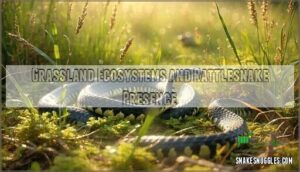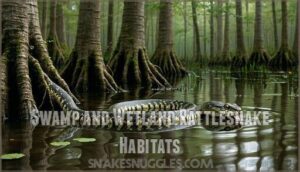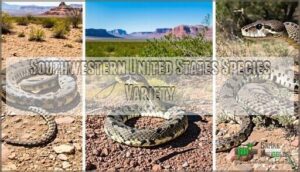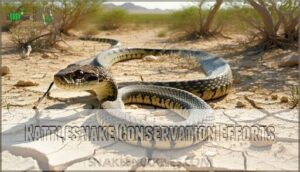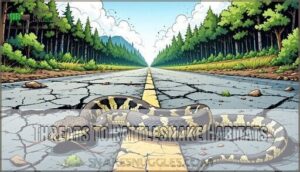This site is supported by our readers. We may earn a commission, at no cost to you, if you purchase through links.
 You’ll encounter rattlesnakes across 48 US states, with only Alaska and Hawaii remaining snake-free due to harsh climates and isolation.
You’ll encounter rattlesnakes across 48 US states, with only Alaska and Hawaii remaining snake-free due to harsh climates and isolation.
The rattlesnake range USA spans from Arizona’s scorching deserts to Florida’s humid swamps, making these adaptable serpents America’s most widespread venomous snakes.
The Southwest boasts the highest diversity, featuring Western Diamondbacks and Sidewinders, while Eastern regions host Eastern Diamondbacks and Timber Rattlesnakes.
These remarkable reptiles thrive in deserts, forests, grasslands, and wetlands, proving they’re nature’s ultimate survivors.
Whether you’re hiking, camping, or relocating, knowing their preferred haunts becomes your first line of defense against unexpected encounters.
Table Of Contents
- Key Takeaways
- Rattlesnake Range in The USA
- States With Rattlesnakes
- Rattlesnake-Free States in The USA
- Preferred Rattlesnake Habitats
- Rattlesnake Adaptations to American Ecosystems
- Rattlesnake Distribution Across Regions
- Rattlesnake Brumation and Winter Dens
- Rattlesnake Conservation Efforts
- Threats to Rattlesnake Habitats
- Geographic Variations in Rattlesnake Populations
- Frequently Asked Questions (FAQs)
- What is the range of rattlesnakes in the United States?
- Where are rattlesnakes found in the US?
- Do rattlesnakes live above 7000 feet?
- What is the strike range of a rattlesnake?
- How Can I Protect Rattlesnakes From Persecution?
- What Do Rattlesnakes Typically Eat?
- How Long Can Rattlesnakes Live?
- What is the Most Toxic Rattlesnake Venom?
- What Are the Signs of a Rattlesnake Bite?
- Where in the US do rattlesnakes live?
- Conclusion
Key Takeaways
- You’ll find rattlesnakes in 45 out of 50 states across America, with only Alaska, Delaware, Hawaii, Maine, and Rhode Island remaining completely snake-free due to harsh climates and geographic isolation.
- Arizona leads the nation with 14 different rattlesnake species, while the Southwest region hosts the greatest diversity of these venomous reptiles compared to other areas of the country.
- These adaptable serpents thrive in diverse habitats including deserts, forests, grasslands, and wetlands, proving they’re nature’s ultimate survivors across America’s varied landscapes.
- Rattlesnakes use specialized heat-sensing organs to detect prey in darkness, sophisticated camouflage patterns that match their environments, and enter brumation (dormancy) during winter months to survive harsh conditions.
Rattlesnake Range in The USA
You’ll find rattlesnakes across most of the continental United States, with 36 species and numerous subspecies distributed from the southwestern deserts to southeastern forests.
Rattlesnakes call 45 states home, from Arizona’s scorching deserts to Florida’s humid swamplands—only five states remain completely snake-free.
Only five states—Alaska, Delaware, Hawaii, Maine, and Rhode Island—remain completely free of these venomous serpents due to climate conditions and geographic isolation, making them unique in terms of rattlesnakes.
States With Rattlesnake Populations
Across the continental United States, you’ll find rattlesnakes inhabiting 45 states with remarkable species diversity.
Each region’s rattlesnake distribution reflects unique habitat requirements and conservation status challenges. Rattlesnakes favor deserts, but also thrive in forests, grasslands, and swamps.
Four key factors shape rattlesnake range USA patterns:
- Species per state varies dramatically—Arizona hosts 14 while Montana has one
- Population density trends show declining numbers in developed areas
- Habitat range shifts occur due to climate pressures
- Venom variations adapt to local prey and environments
Regional Distribution of Rattlesnakes
Rattlesnake distribution across America creates distinct regional patterns you’ll notice immediately.
The Southwest dominates as their stronghold, while eastern forests shelter different species entirely. These Endemic Species Hotspots showcase nature’s adaptability perfectly.
- Desert Southwest – Arizona leads with 14 species thriving in arid rattlesnake habitats in USA
- Eastern Forests – Timber rattlesnakes prefer dense woodland cover
- Great Plains – Prairie species dominate grassland ecosystems
Factors Influencing Rattlesnake Range
Several key factors determine where you’ll find rattlesnakes across America.
Climate drives their distribution—these cold-blooded reptiles can’t survive where ground freezes solid.
Habitat quality matters too, from desert rocks to forest floors.
| Factor | Impact | Example |
|---|---|---|
| Climate | Temperature limits range | No rattlesnakes in Alaska’s frozen ground |
| Prey | Determines population density | Rodent-rich areas support more snakes |
| Human Impact | Reduces available habitat | Urban development fragments snake territories |
Competition and prey availability shape rattlesnake species populations nationwide.
States With Rattlesnakes
You’ll find rattlesnakes in 45 out of 50 states across America, with the Southwest hosting the greatest diversity of species.
Only Alaska, Delaware, Hawaii, Maine, and Rhode Island remain completely free of these venomous reptiles due to climate conditions and geographic isolation.
Arizona’s Diverse Rattlesnake Species
Arizona hosts 17 rattlesnake species across diverse deserts, making Species Identification essential for your safety.
Arizona’s desert wilderness conceals 17 deadly rattlesnake species—knowing which one you’re facing could save your life.
These venomous serpents display varying Venom Potency levels, with some Human Encounters proving more dangerous than others. Their Conservation Status varies substantially throughout different habitats.
Here’s what you’ll encounter in Arizona’s rattlesnake distribution:
- Western Diamondbacks patrolling sun-baked desert floors with distinctive diamond patterns
- Mojave Rattlesnakes lurking in sandy flats with potent neurotoxic venom
- Northern Blacktailed Rattlesnakes hiding among Phoenix-area mountain rocks
Texas and Its Rattlesnake-rich Regions
With ten rattlesnake species calling Texas home, you’ll find impressive habitat variation across the Lone Star State.
Texas species range from desert dwellers to forest inhabitants, each with distinct venom potency levels.
If you’re looking for Texas rattlesnake merchandise, there are many options available.
- Western Diamondback—state’s largest, found statewide
- Prairie Rattlesnake—western Panhandle grasslands
- Timber Rattlesnake—eastern forests, significant size
- Western Massasauga—north-central regions, nocturnal behavior
New Mexico’s Rattlesnake Hotspots
Moving west from Texas, you’ll find New Mexico hosts seven rattlesnake species across diverse landscapes.
The western diamondback dominates flat plains and rocky canyons, while prairie rattlesnakes favor Taos County’s terrain.
Species identification becomes essential as you encounter black-tailed rattlesnakes in mountainous regions and the rare ridgenose in southwestern areas.
Understanding snake distribution helps with encounter prevention throughout New Mexico’s varied rattlesnake habitat.
California’s Rattlesnake Diversity
California’s rattlesnake species showcase remarkable diversity across the state’s varied landscapes.
You’ll find these fascinating reptiles from coastal regions to desert valleys, each adapted to specific environments. Species identification becomes essential when exploring California’s outdoors, as venom potency varies substantially between species.
- Western Diamondback Rattlesnake – Found in southern California’s arid regions
- Mojave Rattlesnake – Known for potent venom in desert areas
- Southern Pacific Rattlesnake – Inhabits coastal and mountain regions
- Sidewinder – Masters of sandy desert navigation
- Red Diamond Rattlesnake – Coastal species with distinctive coloration
Rattlesnake-Free States in The USA
You won’t encounter rattlesnakes in five U.S. states: Alaska, Delaware, Hawaii, Maine, and Rhode Island.
These states lack suitable habitats due to cold climates, geographic isolation, or environmental conditions that prevent rattlesnake populations from establishing themselves, which is a key factor in the absence of rattlesnakes.
Alaska’s Cold Climate and Lack of Rattlesnakes
You won’t find rattlesnakes slithering through Alaska’s wilderness.
Alaskan Temperatures drop far below what these cold-blooded reptiles can handle, creating Freezing Ground that prevents Brumation Inability.
Alaska represents the Northern Limits of rattlesnake distribution in the USA.
The state’s Habitat Suitability simply doesn’t exist for these heat-seeking serpents, making any snake range map show Alaska as completely rattlesnake-free territory.
Hawaii’s Island Isolation From Rattlesnakes
You’ll never encounter rattlesnakes in Hawaii thanks to island biogeography and geological isolation.
The Pacific Ocean creates an impenetrable barrier that prevents these snakes from naturally reaching the islands.
Hawaii’s unique evolutionary pressures shaped ecosystems without venomous snakes, while strict regulations prevent introduced species from establishing populations.
- Ocean barriers block natural snake migration
- Strict quarantine laws prevent accidental introductions
- Native ecosystems evolved without venomous threats
- Climate monitoring guarantees future scenarios remain snake-free
Maine’s Unsuitable Habitat for Rattlesnakes
Maine’s climate creates insurmountable habitat limitations for rattlesnakes.
The state’s harsh winters freeze ground solid, preventing essential brumation.
Geographic isolation from southern populations, combined with food scarcity of preferred prey species, makes survival impossible.
While historical presence existed centuries ago, Maine’s unsuitable rattlesnake habitat conditions have permanently eliminated these reptiles from the state’s snake distribution.
Rhode Island’s Absence of Native Rattlesnakes
You won’t find rattlesnakes slithering through Rhode Island’s forests today.
Island biogeography and glacial history shaped this outcome, creating dispersal barriers that limited snake colonization.
The state’s habitat suitability declined due to development, while limited prey availability made survival challenging.
Modern rattlesnake range maps and snake range maps confirm Rhode Island’s status among rattlesnake-free states, reflecting broader rattlesnake distribution patterns across northeastern regions.
This is partly due to the state’s unsuitable habitat for the species.
Preferred Rattlesnake Habitats
You’ll find rattlesnakes in remarkably diverse environments across the United States, from scorching southwestern deserts and dense eastern forests to expansive grasslands and coastal wetlands.
Understanding these habitat preferences helps you recognize where you’re most likely to encounter these adaptable reptiles during outdoor activities, which is crucial for outdoor activities.
Desert Environments Favored by Rattlesnakes
America’s deserts provide perfect rattlesnake habitat where these remarkable serpents showcase their Arid Adaptations. You’ll find species like Arizona’s sidewinders using Desert Camouflage to blend seamlessly with sandy terrain.
Their Heat Tolerance and Water Conservation abilities let them thrive where temperatures soar above 100°F. Prey Availability remains high with abundant rodents and small mammals.
Many enthusiasts recreate a rattlesnake’s natural habitat in captivity.
- Heat-sensing pits detect warm-blooded prey in darkness
- Specialized scales reflect sunlight and reduce water loss
- Behavioral thermoregulation helps maintain ideal body temperature
- Efficient kidney function minimizes water waste in arid conditions
Forested Areas Supporting Rattlesnake Populations
Dense woodlands provide essential rattlesnake habitat for Timber rattlesnakes and other rattlesnake species.
Forest Canopy coverage and Understory Density create perfect hiding spots, while Forest Fragmentation from Logging Impacts threatens their homes.
Smart Forest Management preserves snake distribution patterns across America’s forests.
Their habitat needs include specific basking platforms.
| Forest Feature | Rattlesnake Benefit |
|---|---|
| Dense Canopy | Temperature regulation and shade |
| Thick Understory | Camouflage and hunting grounds |
| Fallen Logs | Winter shelter and basking spots |
| Leaf Litter | Prey attraction and concealment |
Grassland Ecosystems and Rattlesnake Presence
Grasslands offer prime rattlesnake habitat where Prairie Rattlesnakes thrive within complex Grassland Food Webs.
You’ll find these adaptable serpents traversing open terrain through strategic hunting patterns:
- Burrowing Animal Interactions create ideal den sites and prey opportunities
- Prairie Dog Ecosystems provide abundant food sources and shelter networks
- Conservation Grazing Effects maintain ideal grass heights for hunting
- Fire Ecology Impacts renew habitat while preserving essential snake distribution patterns
Swamp and Wetland Rattlesnake Habitats
You’ll find rattlesnakes thriving in swamps and wetlands across coastal habitats and floodplains.
These wetland species showcase remarkable swamp adaptations, swimming through marshes while hunting amphibians and fish.
Their aquatic hunting skills let them navigate floodplain survival challenges effectively, and Eastern diamondbacks excel in these snake habitats, using specialized techniques for wetland habitats success in rattlesnake habitat environments.
Rattlesnake Adaptations to American Ecosystems
You’ll discover how rattlesnakes have evolved remarkable survival mechanisms that allow them to thrive across America’s diverse landscapes, from scorching southwestern deserts to humid southeastern swamps.
These adaptations include specialized heat-sensing organs for detecting prey in darkness, sophisticated camouflage patterns that match their specific environments, behavioral strategies for surviving harsh winters, and even swimming abilities that help them navigate wetland habitats, showcasing their ability to adapt to various environments with remarkable survival tactics.
Heat-sensing Organs for Desert Survival
Rattlesnakes possess remarkable heat-sensing pits that detect infrared radiation from warm-blooded prey.
These specialized organs enable precise nocturnal hunting in complete darkness, allowing prey detection from several feet away.
Desert rattlesnakes rely on pit organ function for survival in harsh environments where visual hunting proves challenging.
- Infrared detection works like thermal goggles, sensing temperature differences as small as 0.003°C
- Heat-sensing pits locate prey up to three feet away in total darkness
- Rattlesnake adaptations include dual sensory systems combining heat detection with traditional senses
Camouflage Techniques in Different Environments
The master of disguise, a rattlesnake’s camouflage techniques vary dramatically across different snake habitats.
Desert camouflage features sandy browns and tans, while forest camouflage displays darker earth tones. Their grassland camouflage mimics dried vegetation patterns perfectly. Wetland camouflage incorporates muddy hues, and seasonal camouflage shifts throughout the year in woodland habitats.
- Spotting one feels like finding a needle in nature’s haystack
- Their patterns mirror surroundings so precisely it’s almost supernatural
- Walking past one unknowingly happens more often than you’d think
Behavioral Adaptations to Cold Climates
Winter weather sends these cold-blooded reptiles into brumation, a survival strategy that’s like nature’s ultimate energy-saving mode.
You’ll find them sharing communal rattlesnake winter dens in rocky crevices, where thermoregulation becomes a group effort.
Their activity reduction and freeze avoidance techniques help them endure months without food, emerging when spring temperatures return.
Swimming Abilities in Aquatic Habitats
You might think rattlesnakes stick to dry land, but they’re surprisingly capable swimmers.
These serpents use aquatic hunting techniques and buoyancy control to navigate freshwater environments.
Coastal adaptation helps species like Florida’s Eastern Diamondbacks reach barrier islands through island colonization.
Their freshwater tolerance and natural rattlesnake swimming abilities make water crossings routine, expanding their snake habitats across diverse American ecosystems.
Rattlesnake Distribution Across Regions
You’ll find rattlesnake species distributed unevenly across America’s diverse regions, with the Southwest hosting the greatest variety while several northern and island states remain completely snake-free.
The distribution patterns reflect each species’ specific habitat requirements, from Arizona’s desert-dwelling sidewinders to the timber rattlesnakes that prefer eastern forests and the prairie species that thrive across the Great Plains.
Southwestern United States Species Variety
The Southwest’s rattlesnake-rich landscape showcases incredible Arizona diversity with 14 species thriving across desert plains to mountain ranges.
This region’s adaptations create perfect conditions for multiple species to flourish.
- Arizona: Western diamondback and 13 other species dominate varied terrains
- Texas species: Nine varieties including timber rattlesnakes across diverse ecosystems
- New Mexico habitats: Prairie rattlesnakes and others inhabit high plains and deserts
Eastern Diamondback Range and Habitat
The eastern diamondback rattlesnake represents America’s largest venomous snake species, commanding respect across its southeastern range.
You’ll find these impressive serpents thriving in coastal wetlands, pine savannas, and Florida islands, where they’ve adapted to diverse environments from North Carolina’s coastal plains to Louisiana’s longleaf pine forests.
Habitat Distribution
- Primary Range: Florida’s barrier islands and pine flatwoods serve as prime habitat, with populations extending through Alabama, Georgia, and the Carolinas
- Preferred Environments: These snakes favor coastal wetlands and pine savannas, though habitat fragmentation threatens their traditional territories
Their conservation status remains concerning due to development pressure and human encroachment. You’ll notice their remarkable swimming abilities allow them to inhabit Florida islands that other rattlesnake species can’t reach.
Understanding snake distribution patterns helps explain why these formidable predators continue thriving in specific southeastern ecosystems despite ongoing environmental challenges.
Prairie Rattlesnake Distribution in Great Plains
Prairie rattlesnakes dominate the Great Plains like scattered puzzle pieces across America’s heartland.
You’ll find these adaptable serpents thriving from southern Canada to northern Mexico, with their rattlesnake distribution spanning multiple states.
Their adaptability allows them to thrive in various ecosystems, but desert environments are especially favored.
- Habitat Fragmentation: Agricultural development splits continuous prairie into isolated patches
- Prey Availability: Abundant rodents and ground-dwelling birds support stable populations
- Climate Variability: Temperature extremes influence seasonal movement patterns
- Conservation Status: Generally stable despite ongoing Human Impact pressures
Timber Rattlesnake Populations in Eastern Forests
You’ll find timber rattlesnakes thriving in Eastern Conservation areas where dense woodlands provide ideal rattlesnake habitat.
These forests offer perfect prey abundance with small mammals and birds.
However, habitat fragmentation from urban development threatens their genetic diversity.
Proper forest management and snake conservation efforts help protect these populations.
Check any snake range map to see how timber rattlesnakes depend on intact woodlands for survival across eastern regions.
Rattlesnake Brumation and Winter Dens
You’ll find rattlesnakes cease movement and feeding during winter months through a process called brumation, which conserves their energy when temperatures drop below their survival threshold.
These cold-blooded reptiles seek shelter in rock crevices, abandoned burrows, and underground dens where they remain dormant until spring temperatures warm their bodies enough to resume normal activities.
Ectothermic Nature of Rattlesnakes
Rattlesnakes can’t generate their own body heat like you do. These cold-blooded reptiles depend entirely on external heat sources for temperature regulation and metabolic rates.
When autumn arrives, their activity patterns shift dramatically as habitat temperature drops, triggering brumation behavior that’s essential for rattlesnake ecology and survival.
- Solar dependency: Rattlesnakes bask in sunlight to warm their bodies and maintain proper functioning
- Metabolic slowdown: Cold temperatures reduce their energy needs by up to 70% during winter months
- Behavioral shifts: Cooler weather forces rattlesnakes to seek shelter and enter prolonged dormancy periods
Importance of Brumation for Survival
Understanding rattlesnake behavior reveals how metabolic slowdown transforms their winter survival strategy.
When brumation triggers activate, energy conservation becomes their lifeline. You’ll witness survival rates climb dramatically as snakes enter this dormant state, slowing their heart rates and breathing patterns.
Smart den selection guarantees they avoid freezing temperatures, making rattlesnake brumation nature’s perfect hibernation alternative for cold-blooded creatures.
| Brumation Benefit | Energy Impact | Survival Outcome |
|---|---|---|
| Reduced metabolism | 80% less energy use | Higher winter survival |
| Slower heart rate | Minimal calorie burn | Extended life span |
| Limited movement | Zero hunting needed | Protected from predators |
Locations of Winter Dens
When winter arrives, you’ll find rattlesnakes seeking rock dens that offer perfect den microclimates for survival.
These strategic locations become hibernacula where snakes brumate safely through harsh months. Communal denning occurs frequently, with multiple species sharing prime spots. Den fidelity means rattlesnakes return to the same locations year after year, making these sites essential for rattlesnake habitat conservation.
Key winter den characteristics include:
- South-facing rocky slopes that capture maximum sunlight and warmth
- Deep crevices and caves providing protection from freezing temperatures
- Abandoned mammal burrows offering ready-made shelter from predators
- Talus slopes and boulder fields creating natural wind barriers
- Elevated locations avoiding flood-prone areas during spring thaws
However, hibernacula threats from development require ongoing den conservation efforts to protect rattlesnake range map distributions.
Rattlesnake Conservation Efforts
You’ll find that many rattlesnake species across America face serious threats from habitat loss, climate change, and human persecution, making conservation efforts critical for their survival.
Scientists, wildlife agencies, and conservation groups work together through protected areas, breeding programs, research initiatives, and protective legislation to guarantee these important predators continue playing their essential role in maintaining healthy ecosystems.
The collaboration among these entities is crucial for the survival of rattlesnake species, as they strive to preserve the delicate balance of the ecosystem.
Protected Areas for Threatened Rattlesnake Species
Government agencies and conservation groups work together to establish protected areas that safeguard threatened rattlesnake species across America.
These efforts focus on habitat preservation and species recovery through targeted conservation funding and legal protections.
- National wildlife refuges provide safe havens for Eastern Massasauga populations in Michigan and Ohio
- State parks maintain critical timber rattlesnake habitats in northeastern forests
- Private land partnerships expand protected corridors connecting fragmented snake ranges
Breeding Programs for Endangered Populations
Captive breeding facilities serve as lifelines for threatened rattlesnake species facing extinction.
These programs enhance genetic diversity while developing effective reintroduction strategies for long-term survival.
Researchers evaluate habitat suitability before releasing captive-bred snakes into protected areas.
Program efficacy depends on maintaining healthy breeding populations and monitoring released individuals.
Snake conservation efforts focus on preserving endangered species through controlled breeding environments.
Habitat loss Captive breeding
Genetic diversity
Reintroduction
Research Initiatives on Rattlesnake Ecology
Scientists use telemetry studies to track rattlesnake movements, creating detailed rattlesnake range maps.
Researchers analyze genetic diversity and venom composition while studying prey relationships in various rattlesnake habitats.
Habitat modeling helps predict population changes.
This rattlesnake research provides essential data for rattlesnake conservation efforts, revealing how climate and human activity affect rattlesnake ecology across different regions nationwide.
Legislation Protecting Rattlesnake Habitats
Federal protection through the Endangered Species Act shields vulnerable rattlesnake populations like Eastern Massasaugas.
State habitat protection laws safeguard critical den sites and foraging areas.
Conservation easements preserve private lands essential for snake survival. However, funding allocations remain limited, creating enforcement challenges.
You’ll find rattlesnake legislation varies substantially between states, with thorough rattlesnake conservation efforts requiring coordinated habitat protection strategies to ensure snake survival.
Threats to Rattlesnake Habitats
You’ll find that rattlesnake populations face mounting pressure from habitat destruction, agricultural expansion, and climate change that’s altering their traditional ranges across the United States.
These environmental threats, combined with human development and pollution, have created significant challenges for rattlesnake survival, particularly affecting species like the timber rattlesnake in northeastern states and the eastern massasauga in the Great Lakes region.
Climate Change Impacts on Rattlesnake Distribution
Climate change reshapes America’s rattlesnake range map through five key impacts:
- Range shifts push species northward as southern habitats become unsuitable
- Temperature effects extend active seasons but stress heat-sensitive populations
- Precipitation changes alter prey availability and den site quality
- Habitat suitability decreases in traditional strongholds like Arizona
- Extinction risks threaten specialized species facing rapid environmental shifts
These shifts can increase human-snake conflict, posing public health risks.
Habitat Loss Due to Agricultural Expansion
How does turning wild prairies into cornfields affect rattlesnakes? Agricultural expansion creates habitat fragmentation, forcing snakes into smaller territories.
Cattle farming tramples den sites, while pesticide use causes prey depletion. Rattlesnake habitat loss accelerates as farms expand.
| Agricultural Impact | Effect on Rattlesnakes |
|---|---|
| Plowing grasslands | Destroys winter dens |
| Pesticide spraying | Kills rodent prey |
| Livestock grazing | Compacts soil hideouts |
| Fence installation | Blocks migration routes |
| Crop monocultures | Eliminates food sources |
Conservation strategies promote wildlife corridors between farmlands.
Effects of Wildfires on Rattlesnake Populations
Wildfires create habitat destruction that forces rattlesnakes to flee their territories, often leading to increased mortality from exposure and prey scarcity.
However, rattlesnake populations show remarkable resilience through post-fire recovery.
These snakes adapt by making range shifts to unburned areas, and snake conservation efforts help monitor how rattlesnake wildfires impact long-term rattlesnake habitat loss patterns.
Pollution and Its Impact on Rattlesnake Ecosystems
Chemical pollutants pose serious threats to rattlesnake habitats across America.
Pesticide Exposure and Heavy Metals contaminate food chains, while Water Pollution degrades essential ecosystems.
Habitat Contamination disrupts rattlesnake ecology and breeding patterns.
Major pollution sources affecting rattlesnake population include:
- Agricultural runoff containing toxic chemicals
- Industrial waste contaminating water sources
- Acid Rain altering soil chemistry
- Urban development introducing harmful substances
- Mining operations releasing heavy metals
These rattlesnake threats require immediate rattlesnake conservation efforts.
Geographic Variations in Rattlesnake Populations
You’ll discover that rattlesnake species and population densities vary dramatically across the United States, with Arizona hosting 14 different species while states like Montana contain only one.
The geographic distribution patterns you observe reflect complex interactions between climate conditions, available habitats, and human development pressures that shape where these venomous snakes can successfully establish and maintain their populations, reflecting the impact of human development pressures.
Regional Differences in Rattlesnake Species
You’ll find remarkable Species Variation across America’s rattlesnake populations, with each region hosting uniquely adapted serpents.
Local Adaptations have shaped distinct characteristics based on Habitat Specificity and prey availability throughout different snake range map territories.
Their distribution is influenced by factors detailed in a snake geographic range map.
- Arizona’s desert species developed heat tolerance and specialized Venom Potency
- Texas rattlesnakes adapted moderate toxicity for diverse terrain hunting
- New Mexico’s high-altitude species evolved cold-weather survival mechanisms
Impact of Climate on Rattlesnake Populations
Climate change creates a domino effect across rattlesnake populations nationwide.
Temperature extremes alter their brumation patterns, while precipitation changes reshape available habitats.
You’ll notice range expansion northward as winters warm, yet some populations decline where conditions become too harsh.
| Climate Factor | Population Impact |
|---|---|
| Rising temperatures | Extended activity seasons |
| Altered rainfall | Habitat shifts eastward |
| Extreme weather | Reduced prey availability |
| Warming winters | Range expansion northward |
Human-Rattlesnake Conflicts in Urban Areas
Urban encroachment brings you face-to-face with rattlesnakes in unexpected places.
Pet encounters spike as development pushes into snake territory. When confronted, don’t handle the situation yourself—call professional rattlesnake removal services.
Effective mitigation strategies include keeping yards tidy and removing brush piles. Public safety depends on proper rattlesnake management, though relocation challenges mean some snakes return to familiar areas.
These snakes play a key role in controlling rodent populations.
Frequently Asked Questions (FAQs)
What is the range of rattlesnakes in the United States?
You’ll find rattlesnakes across the continental United States, from southern Canada to central Argentina.
Arizona leads with 14 species, while Alaska, Hawaii, and Maine remain completely rattlesnake-free for your peace of mind.
Where are rattlesnakes found in the US?
Like scattered puzzle pieces across a vast map, you’ll find rattlesnakes throughout the continental United States.
They’re absent from Alaska, Hawaii, Maine, Delaware, and Rhode Island, but thrive everywhere else, especially in southwestern states.
Do rattlesnakes live above 7000 feet?
Yes, you’ll find rattlesnakes at elevations above 7000 feet in several western states.
They’ve adapted to mountainous terrain in Arizona, New Mexico, and California, though they’re less common at higher altitudes than lower elevations, which is a notable adaptation.
What is the strike range of a rattlesnake?
A rattlesnake can strike approximately two-thirds of its body length.
If you encounter a six-foot snake, stay at least four feet away.
They’re surprisingly quick, so give them plenty of space for everyone’s safety.
How Can I Protect Rattlesnakes From Persecution?
Educate others about rattlesnakes’ ecological importance in controlling rodent populations.
Support habitat conservation efforts and legislation protecting these species.
Report illegal killing to wildlife authorities.
Share factual information to dispel myths and reduce fear-based persecution.
What Do Rattlesnakes Typically Eat?
You’ll find rattlesnakes primarily hunt small mammals like rodents, rabbits, and squirrels.
They also consume birds, lizards, and occasionally frogs.
These ambush predators use their heat-sensing abilities to detect warm-blooded prey effectively.
How Long Can Rattlesnakes Live?
In the wild, you’ll find rattlesnakes living 15-25 years on average, though some reach 30 years.
Captive snakes often live longer due to consistent food, veterinary care, and protection from predators and harsh weather conditions, which can be considered as protection.
What is the Most Toxic Rattlesnake Venom?
The Mojave rattlesnake packs the most toxic venom among rattlesnake species.
Its venom is a potent mix of neurotoxins and hemotoxins, causing severe damage.
If you encounter one, steer clear and stay safe!
What Are the Signs of a Rattlesnake Bite?
Ironically, you mightn’t feel the bite immediately.
Look for two puncture wounds, intense burning pain, rapid swelling, nausea, dizziness, and metallic taste.
Your skin may turn blue or numb around the bite area.
Where in the US do rattlesnakes live?
You’ll encounter rattlesnakes across most of the continental United States, with Arizona hosting the highest diversity at 14 species.
They’re absent from Alaska, Hawaii, Maine, Delaware, and Rhode Island due to climate limitations.
Conclusion
Knowledge is power in the context of rattlesnake encounters across America.
Understanding the rattlesnake range USA helps you stay safe while exploring our nation’s diverse landscapes.
You’ve learned which 48 states host these remarkable reptiles and discovered their preferred habitats from Arizona’s deserts to Florida’s swamps.
Armed with this information, you can confidently venture outdoors, knowing where to expect these adaptable serpents and how they’ve mastered survival in America’s varied ecosystems to stay safe, with complete concepts of their habitats.
- https://www.iucnredlist.org/species/64318/12765920
- https://www.michigan.gov/dnr/0,4570,7-350--32995--,00.html
- http://oplin.org/snake/fact%20pages/rattlesnake_e_mass/rattlesnake_e_mass.html
- https://pubs.nmsu.edu/_circulars/CR541/index.html
- https://maineaudubon.org/news/5-creatures-you-may-not-know-used-to-live-in-maine/





